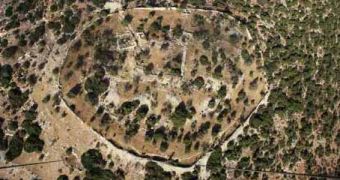The Biblical place of Elah Valley, where possibly the most ancient Hebrew inscription was recently discovered on a pottery shard, was again brought to the attention of archaeologists and scholars. This time, a team of experts, including archaeologist Yosef Garfinkel from the Hebrew University, has unearthed a second fortified gate to the Elah Fortress (Khirbet Qeiyafa in Arabic), possibly providing hints to the existence of the city of Sha'arayim, (Hebrew for "Two gates"), mentioned in the Bible.
The book describes the place as the location of the famous battle between the future King David, at the time only a boy, and the giant Philistine Goliath. The region is situated next to the modern Israeli city of Bet Shemesh. The huge gate, which is made of stones – some of them weighing up to 10 tons - is in the eastern part of the site, opening towards the city of Jerusalem. "All the sites from this period uncovered so far had only one gate. We have two gates and this is very unusual," shared Garfinkel, quoted by National Geographic.
Sha'arayim appears three times in the Bible, twice being associated with David. "Everything comes together - the geography, the Bible, and the radiometric dating. It's no coincidence," shared Garfinkel. Opinions on the relevance of the finding are different, though, with some skeptical scholars still cautious in attributing the city to King David, especially since it's not yet clear whether a Judean or a Philistine population was in control of the fortress.
"It doesn't matter if there is a second gate […] This provides no indication of a Judean population there," stated Amos Kloner, an Israel studies professor at Bar Ilan University and former district archaeologist at Elah. He is backed up by Israel Knohl, a Biblical studies expert at the Hebrew University in Jerusalem, "The main problem with this site is that we still need unequivocal proof that it was a city of Judeans". Also, he believes that finding the second gate "is of secondary importance […] At the moment, we cannot determine with certainty this was Sha'arayim or that it was a Judean city".
In spite of the criticism, Garfinkel remains optimistic as he keeps exploring the site for further proof. He even jokes about it, "Maybe we'll find an inscription on the gate indicating who built the city: 'I David, son of Yishai, built this city'".

 14 DAY TRIAL //
14 DAY TRIAL //